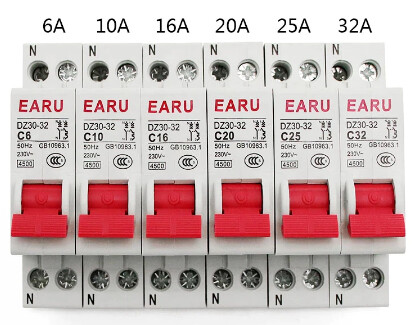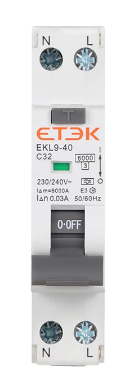AFAIK:
Earth leakage protection became mandatory in ZA in 1974.
Earth leakage protection became mandatory in the UK in 2008.
Take what you will from that.
AFAIK:
Earth leakage protection became mandatory in ZA in 1974.
Earth leakage protection became mandatory in the UK in 2008.
Take what you will from that.
I’m not even sure if it is mandatory in the US yet. A GFCI-socket (which is like a socket with a built-in RCD) is required in certain locations (kitchens, bathrooms, anywhere there is water), but they have nothing on the same level as the UK or ZA.
The UK also has this weird thing called “ring circuits”… ![]()
I recently had a ring circuit signed off on a COC in ZA.
The electrician was very reg conscious and quoted me chapter and verse at the time.
I had to fit these at each socket to be compliant:

Limiting each socket to 16A allowed a 4mm2 ring circuit with a larger MCB in the DB.
(On E/L of course)
There is a Youtube channel, Artisan electrics, where they frequently deal with ring circuits. The one advantage I can see is how easy it is to test that you have good continuity. You can literally pull the two legs out from the breaker in the distribution board, and test the continuity. That is not at all a bad feature!
thanks for the reply, so as it stands, i have 2 earth leakages, one running all my circuits through the inverter and another running everything thats fed through utility only, the earth leakage running the circuits through the inverter is the problematic one. interms of the type of earth leakage, i can not say, my installer did all the purchasing, ill try and upload pics.
That’s a R300 RCD. I cannot find a spec sheet for it, but I’d be very surprised if it is anything more than the most basic type-AC RCD.
My suggestion is to split that row marked as “inverter circuit” into two halves, each with their own RCD and neutral bar. I can however see that’s going to be difficult. You have hardly enough space for an RCD, let alone another neutral bar. Depending on the number of circuits/sockets served by the breakers, you may be able to consolidate them onto less breakers (eg, maybe you can get away with 6 breakers instead of the 9 I see now). Your sparky should know. That should provide space for another RCD, and a DIN-mount neutral bar at the end (hopefully).
That should leave you with 6 circuits, split into two groups of 3 each, each group with its own RCD.
What are those 9 circuits used for? Are they so heavy that they each need a dedicated breaker?
Edit: Alternatively, replace all 9 breakers with RCBOs and toss the RCD. They are around R500 a piece, for the cheapest one I could find on RS components, which does mean somewhat of a hectic price. Then every circuit has its own residual current protection, and not only do you divide the standing leakage by 9… a problematic appliance trips only the circuit it is on.
so the pic shows the layout of what each circuit does, ill speak to my sparky to perhaps split it for me and maybe change each RCD to a RCD-Type A and see if that improves however its just very strange how that this is happening, let me explain…
During load shedding no Utility power and solar power available - NO TRIPS
During load shedding no Utility power and NO solar power available - NO TRIPS
when i implement the change over from the solar to utility i experience - NO TRIPS
Utility power available and solar power available - TRIPS (Started happening a week ago)
Utility power available and NO solar power available - TRIPS HEAVILY
Whats odd though is when the sparky did the install of the inverter and battery, the panels were only installed 2 weeks after the fact due to shipping delays, during that time, i experienced no trips, the tipping only started once the solar panels were installed.
Once the earth leakage trips the only way to restore power will be to turn down all the circuits connected to the inverter circuit and than put the earth leakage up, once thats done than turn on each circuit individually.
another way is to trip the main switch than i can turn on the earth leakage
another way is to trip the AC INPUT and AC OUTPUT, than the earth leakage will be abled to be turned on.
This crap has already costed me 60k worth of damages such as my Kettle, microwave, fridges and freezers as well as my TV. All slowly gave in due to the constantly lose of power.
What kind of inverter have you got? It may well be that all this discussion we’ve been having about DC-leaks and non-isolated topologies may not be off-topic…
Rebel Energy Max
I am also using a Dyness 5.12kw battery
data sheet below
Aaah it is a rebadged Axpert VM4.
Specs says max PV is 450V, so the topology is likely to switch it directly to the AC grid, possibly without galvanic isolation.
Are the solar panels (the frames) earthed?
yeah it probably is rebranded, i had an issue with the BMS, managed to get it working with an Axpert cable.
i am not sure if they are ill have to confirm with my sparky. in terms of the type of panels they are the 455w Canadian panels with the MC4 connectors, i am not sure if you would need to earth them.
Oh it definitely is rebranded, but that is not necessarily a bad thing. That’s Voltronic’s whole business model. Let’s just say we are not big Voltronic fans in these parts ![]()
It needs to be earthed according to our regulations. Just the frame. The DC from the panels should not be earthed, they must remain floating (if this is the topology I think it is). The reason I thought of this, is because all sorts of weird capacitive coupling can happen between the panels and some other surface, where AC is involved. I’m mentally exploring the idea that there is indeed some kind of leak through the panels. That Video @Phil.g00 posted earlier explains it well.
okay let me confirm with my sparky and get back to you.
thank you for the help thus far, really appreciate it.
I highly doubt that will help. The problem with Type AC E/Ls discussed above is that they won’t trip when they should. That is the opposite of this behaviour.
You also say it happens when solely on the grid if I understand correctly?
Occam’s razor would say you have an earth fault.
Nevertheless, a quick test is to swap the position of your two E/Ls around. If the fault travels with the device, you have your answer.
I suspect it won’t, though.
Most people don’t have an AVO or a megger, so I’ll describe a diagnostic technique that only requires a screwdriver.
When there is an L-E fault you can find it quite easily with a process of elimination. The E/L will only reset with the faulty circuit’s MCB off. It will reset with all none faulty circuits’ MCBs on.
Once you have identified the circuit, keep in mind it may not be the wiring but an appliance, so then you have to plug out all the appliances on that circuit and see if you can reset the E/L through a process of elimination of plugging the appliances back in.
Your description indicates that all MCBs must be off to reset.
I rather suspect you have a high resistance N-E fault as that is where all the circuits will be commoned together. This could also be an appliance.
It is more tedious to find but essentially involves a similar process as an L-E fault, but the neutrals have to be broken individually, which is a PITA.
Of course, If you are uncomfortable around electricity, hire a sparky.
These days I use these, which fit in the same 18mm slot and break both live and neutral and will make finding an earth fault child’s play. ( Cheap as chips).

But I may start using these Type A’s:

ETEK RCBO Type A Residual Automatic Circuit Breaker 6KA 1P+N 2P 20a With Over Current Leakage Protection 30mA
€ 6,27 free shipping on aliexpress. It would be rude not to.
Indeed. Which is why my first reply at the top had that part in bold… I assume the sparky checked that ![]()
The trouble, as you mention, is that if it is a neutral/earth fault, then turning off the MCBs doesn’t help. It sometimes appears to help (because it likely lowers the leak just enough), but you end up in this frustrating situation where the fault seems to move around or always be present, with no clear pattern. In order to properly eliminate a circuit both the live and neutral must be disconnected. That also means you need to know which live and neutral goes together…
And that is why this ^^^ is invaluable!
If I ever redo a DB, I will probably use RCBOs throughout.
Before the inverter, battery or panels were installed i had no issues
it trips solely on
Grid+Solar+Battery = TRIP
Grid+Battery = TRIP
Solar + Battery = NO TRIP
Battery alone = NO TRIP
That might be a red herring.
I’d have your sparky check that the E/L actually trips with one of these (below) when the grid isn’t present.
The test button isn’t good enough. That test button only allows some current to bypass the internal CT. The test will work with only L & N present.
You need to establish the integrity of the earthing when your only source is the inverter.
It may be that without the grid, you don’t have a source earth.
You may be drawing an incorrect conclusion because you don’t have E/L protection when you are on solar only.

Hi, I have the same/similar issue.
The ELCB trips when the grid is restored.
Remove any surge protection multi-plugs you may have.
Disconnect the kitchen appliances.
Disconnect the gate motor… to determine is any of these are causing the problem.
These are the main culprits.
Is you inverter connected before the Main incoming ELCB or after the ELCB?
@Phil.g00 , I also wonder about the TN-bonding. I mean that is a topic we discussed to death over the years. Some inverters have them, some don’t, some need an external box. The old 5kVA Axperts had that since around 2017, so I would be surprised if it was omitted in the VM4… but who knows. Without a functional TN bond while islanded, a real earth fault will go unnoticed while in inverter mode, and show up when connected to the grid.
Maybe he needs a second opinion about all this, you know, in the sense we use that term when a doctor gives you an answer you don’t like ![]()
I once asked my friend’s mother why she used a 2-pin extension lead to plug her washing machine into a distant plug socket into the laundry. Why didn’t she use the plug socket that was right next to the washing machine and dispense with the extension?
I was told that the near socket was faulty because it kept tripping the earth leakage.
In reality, there was no earth connection through the 2 wire extension, and there was nothing wrong with the nearest socket. The problem was the washing machine.
She drew an understandable conclusion but was completely wrong.
I suspect something similar is happening here.